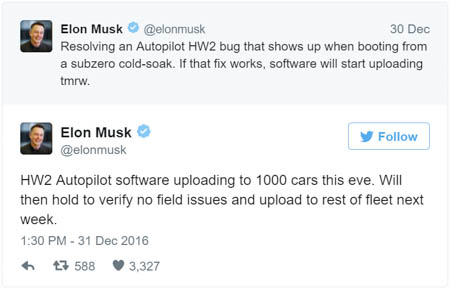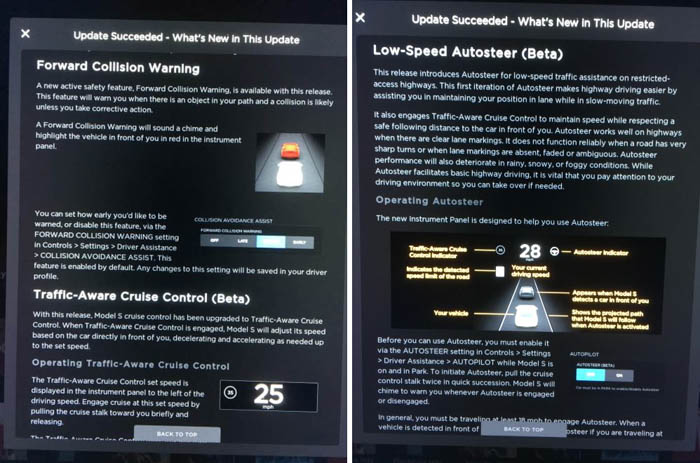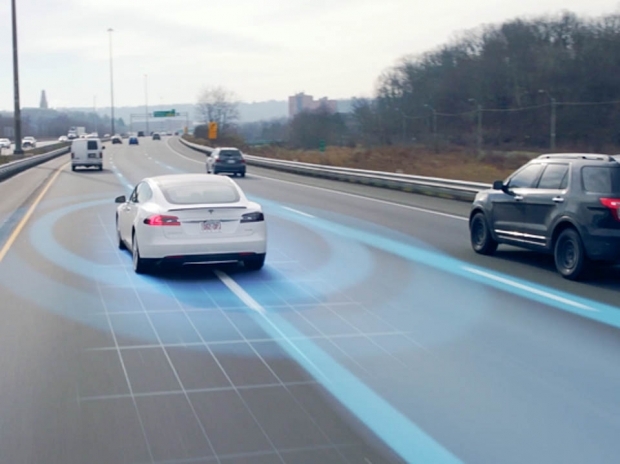To put the update in context, it is first important to give a brief history of Tesla’s autopilot feature rollout. A few months ago, company chief executive Elon Musk announced that all Model S and Model X vehicles produced at the company’s Fremont, California factory after October would include an upgraded self-driving Autopilot hardware suite called “Hardware 2.” Rather than featuring a single monochrome camera and twelve ultrasonic sensors, these vehicles are now equipped with eight cameras, one radar antenna, twelve ultrasonic sensors with double the range, and Nvidia’s Drive PX 2 computing platform with updated image processing software.

Tesla's Enhanced Autopilot "Hardware 2" suite (via Electrek)
For the first few months of operation, however, these more fully-equipped autopilot vehicles have been driving in “learning mode” and have not yet received feature parity with less-capable Hardware 1 models. The delay resulted in first-generation vehicles receiving standard safety improvements like automatic emergency braking, collision warning, Autosteer (lane keeping), and adaptive cruise control much earlier than newer, more expensive counterparts.
Enhanced Autopilot vehicles support Level 5 autonomy
As it stands, one of the main differences between Tesla’s first and second-generation Autopilot hardware suites is the level of autonomy that each vehicle is able to achieve. In 2014, the Society of Automotive Engineers published a classification chart for automated vehicle systems featuring six different levels of capabilities. At Level 0, an automated system has no control over a vehicle, but can still issue warnings. At Level 3, a driver can safely direct attention away from operation, but should be ready to take control when needed. At the highest Level 5, the system can basically drive to any location, charted or uncharted, without any human intervention required.
Since mid-October 2015, all of Tesla’s Hardware 1 vehicles running software version 7 have been able to achieve an autonomy rating somewhere between Level 2 and 3. Moving forward with recent Hardware 2 models in October 2016, Tesla's original plan for “Enhanced Autopilot” (Autopilot 2.0) was to achieve autonomy somewhere between Level 3 to 4. But thanks to the seamless integration of a 360-degree camera system and processing improvements Tesla Vision imaging software, the final version now ends up at Level 5.
Hardware 1 and 2 vehicles now at software parity, but features still in Beta

Source: Twitter
On Saturday, Musk tweeted that Enhanced Autopilot features would be uploading to the first 1,000 vehicles from its Hardware 2 production line by New Year’s Eve, with more rollouts on the way later this week. The update comes after the company fixed a bug that prevented its vehicles from booting while operating in sub-zero temperatures.
At last, the Autopilot 2.0 rollout now includes Traffic Aware Cruise Control, Forward Collision Warning and Autosteer, but unfortunately they will only be enabled at “low-speed” and as beta features for now. In other words, the company still remains cautious about letting its customers evaluate these capabilities even on fully-equipped models, and it wants to avoid any unnecessary collisions in the process by refining the software through regular data collection. As of December, the company has collected over 1.3 billion miles of Autopilot data from early Hardware 2 vehicle adopters in order to bring them to feature parity with first-generation owners.
Source: Electrek
“We’ve designed these new Autopilot features to give you more confidence behind the wheel, increase your safety on the road, and make driving in traffic less frustrating,” says the company release notes. “Similar to the autopilot function in airplanes, you need to maintain control and responsibility of your vehicle while enjoying the convenience of Autopilot in Model S.”
“These features operate on a new hardware and software platform. Therefore, their rollout will be measured and cautious until we have generated confidence across several hundred million miles of real-world usage. Enhanced Autopilot will become better over time as this experience is gained and corner cases are addressed. In the meantime, it is particularly important that you remain vigilant and in control when using driver assistance features.”
Software update 8.1 delayed
Meanwhile, owners of first-generation Autopilot vehicles produced after October 2014 and second-generation owners not in the first 1,000 cars will need to wait until the end of January to receive software update 8.1. This release will bring the aforementioned low-speed features to the rest of Tesla’s Autopilot customer base as it continues to work on its long-term goal of enabling the Level 5 “full self-driving” feature set by the end of this year.




